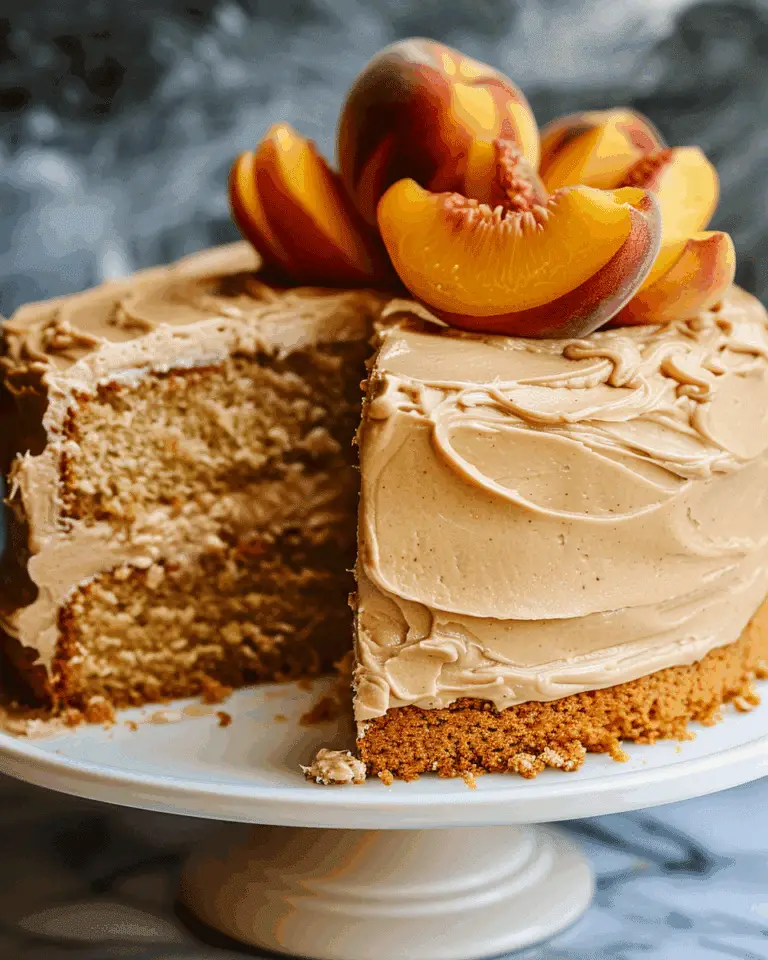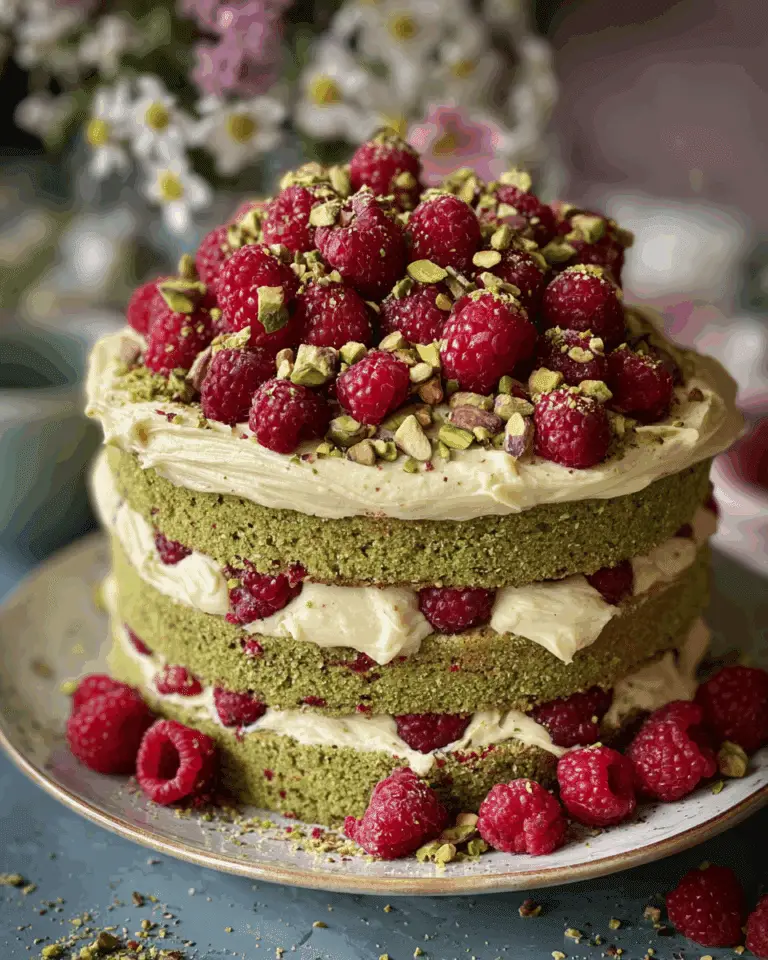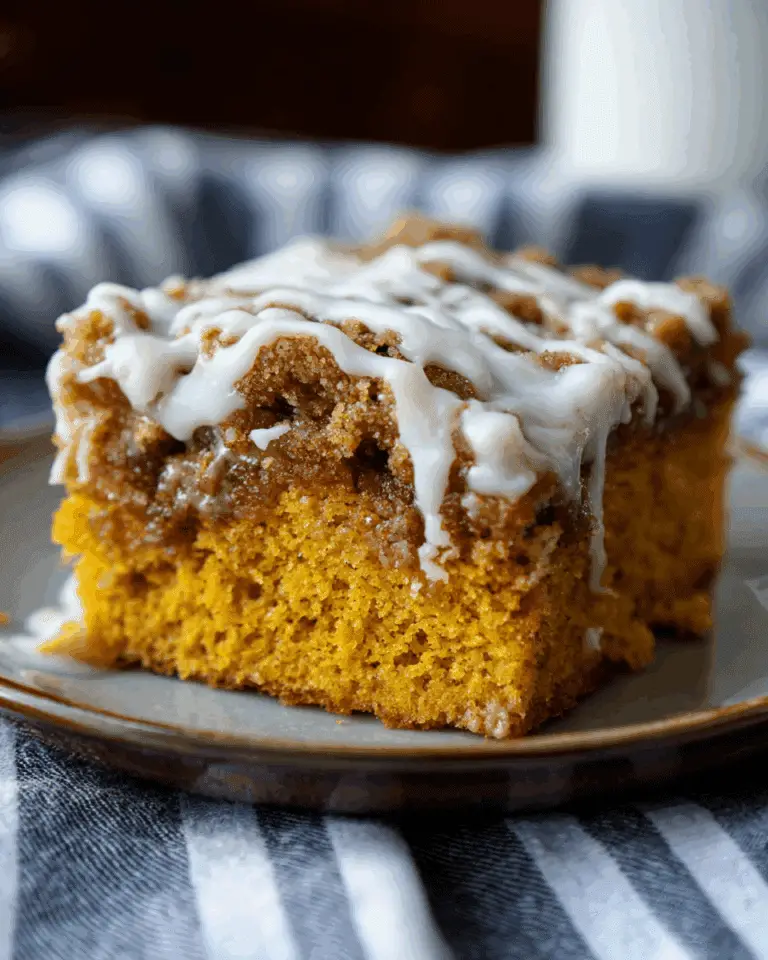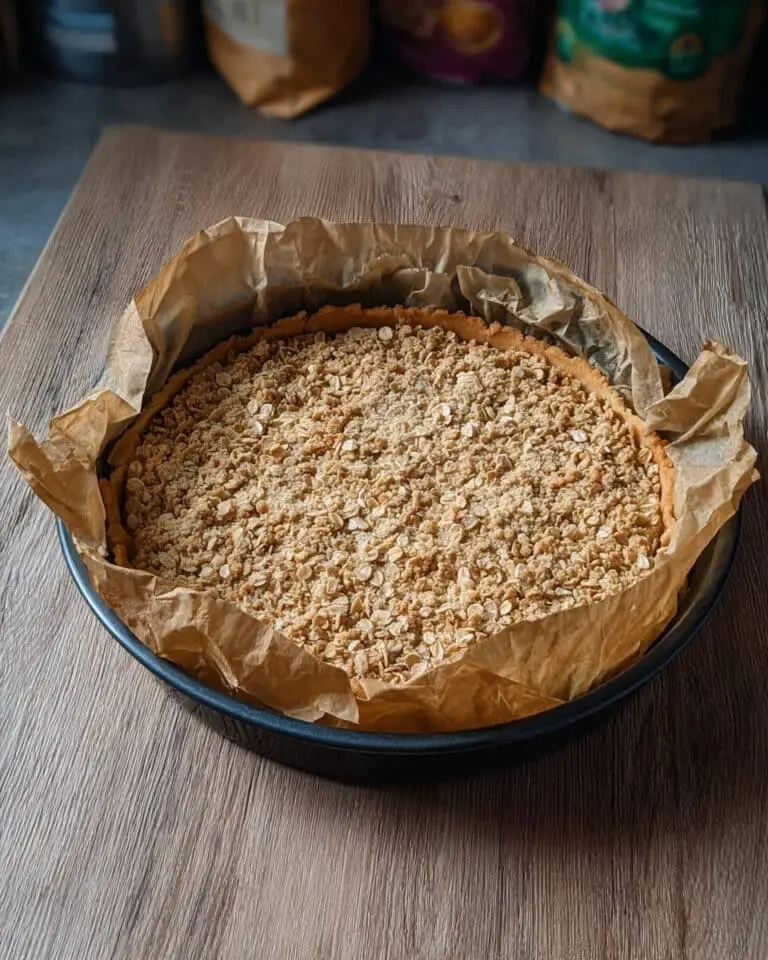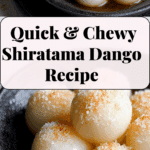Shiratama Dango (Rice Dumplings/Mochi Balls) are one of those delightful Japanese treats that instantly make any ordinary day feel extra special. With their tender, chewy bite and blank-canvas flavor, they’re the perfect vessel for a variety of delicious toppings, whether you crave a drizzle of dark brown syrup, a dusting of roasted soybean flour, or something even more creative. Best of all, these adorable mochi balls come together in just 15 minutes with simple ingredients, making them as much fun to make as they are to eat. If you’ve been looking for an authentic, vegan-friendly way to bring a touch of Japanese dessert magic to your kitchen, this recipe is absolutely for you!
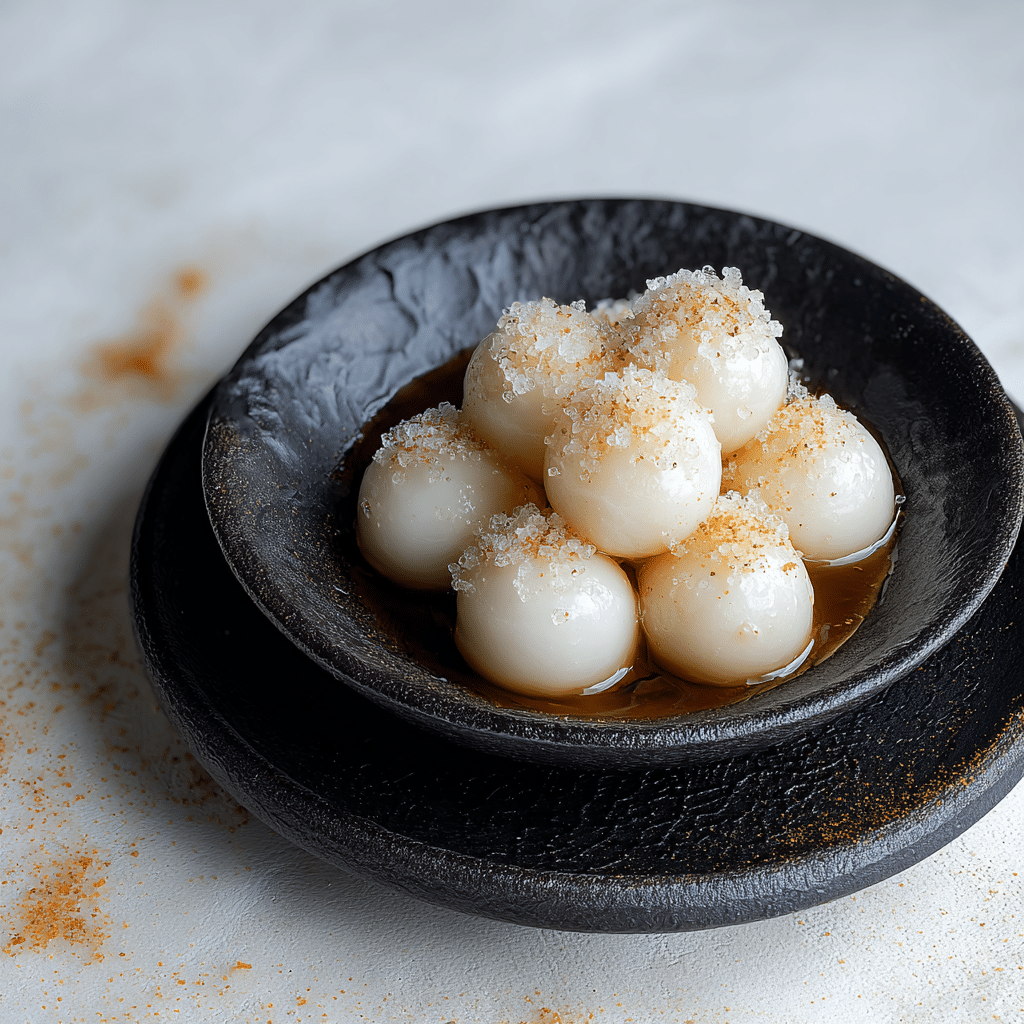
Ingredients You’ll Need
The beauty of Shiratama Dango (Rice Dumplings/Mochi Balls) is how few ingredients you need for such satisfying results. Each one plays a key role—ensuring the dumplings are tender, chewy, and able to soak up all your favorite toppings! Here’s what you’ll need to create your own batch:
- Shiratamako (Glutinous Rice Flour): This specialty flour gives the dango their unbeatable chewy texture. If you can find shiratamako, use it for the best results.
- Water: Carefully measured water brings the dough together and achieves that “earlobe” consistency (it’s a Japanese culinary term for soft, elastic dough).
- Mochiko (Alternative): If shiratamako isn’t available, mochiko (sweet rice flour) mixed with potato starch makes a good backup for dango with just a slightly different bite.
- Potato Starch (Katakuriko or Tapioca Starch): Used with mochiko to add a little extra spring to the dough, keeping your dango pleasantly chewy.
- Dark Brown Sugar Syrup (Kuromitsu): This sweet, molasses-like syrup is a classic topping, adding rich flavor and a touch of decadence.
- Roasted Soybean Powder (Kinako): Earthy and nutty, kinako gives a finishing sprinkle that’s both beautiful and delicious. Try both toppings!
How to Make
Step 1: Prepare the Dough
Start by whisking your glutinous rice flour—if you have shiratamako, use 100g for the traditional texture; whisking helps prevent lumps. Gradually add half your measured water, mixing gently until incorporated, then add the rest just a little at a time. The goal is a smooth, elastic dough that feels soft, like the lobe of your ear! If you’re using the mochiko method, simply mix in the potato starch and gradually blend in your water. Take your time here—don’t rush the water addition, or your dough may end up too sticky to shape.
Step 2: Shape the Dango
While your pot of water heats up, divide the dough into even portions. Roll each section between your palms to make even cylinders, then cut each into about ten pieces (but you can go larger or smaller if you like). Roll each piece into a smooth, round ball, then gently press a small indentation in the center—this helps the dango cook evenly and also gives that classic dimpled dango look. Lay them on parchment paper to keep them from sticking while you work.
Step 3: Cook the Shiratama Dango
With your water at a boil, carefully drop the dango in, stirring occasionally with chopsticks to prevent sticking. The magic moment comes when they float to the surface—this just takes about three minutes! Let them bob for another minute to cook through, then immediately scoop them out and transfer to a bowl of ice-cold water. This step “shocks” the dango, locking in their perfect chewy-soft texture.
Step 4: Cool and Serve
Let the Shiratama Dango (Rice Dumplings/Mochi Balls) chill in their ice bath for 5 to 10 minutes—this not only cools them quickly but makes each bite extra satisfying. Drain off excess water, and your dango are ready for their moment in the spotlight! Place them on a pretty plate and go wild with toppings like kuromitsu, kinako, or even a scoop of ice cream.
Step 5: Storage and Leftovers
If you’re somehow left with extra dango (which is rare, but it happens), arrange them on a parchment-lined tray and pop them in the freezer for about an hour. Once firm, transfer to a freezer-safe bag and store for up to a month. For a quick treat later, just thaw and reheat—your future self will thank you!
How to Serve Shiratama
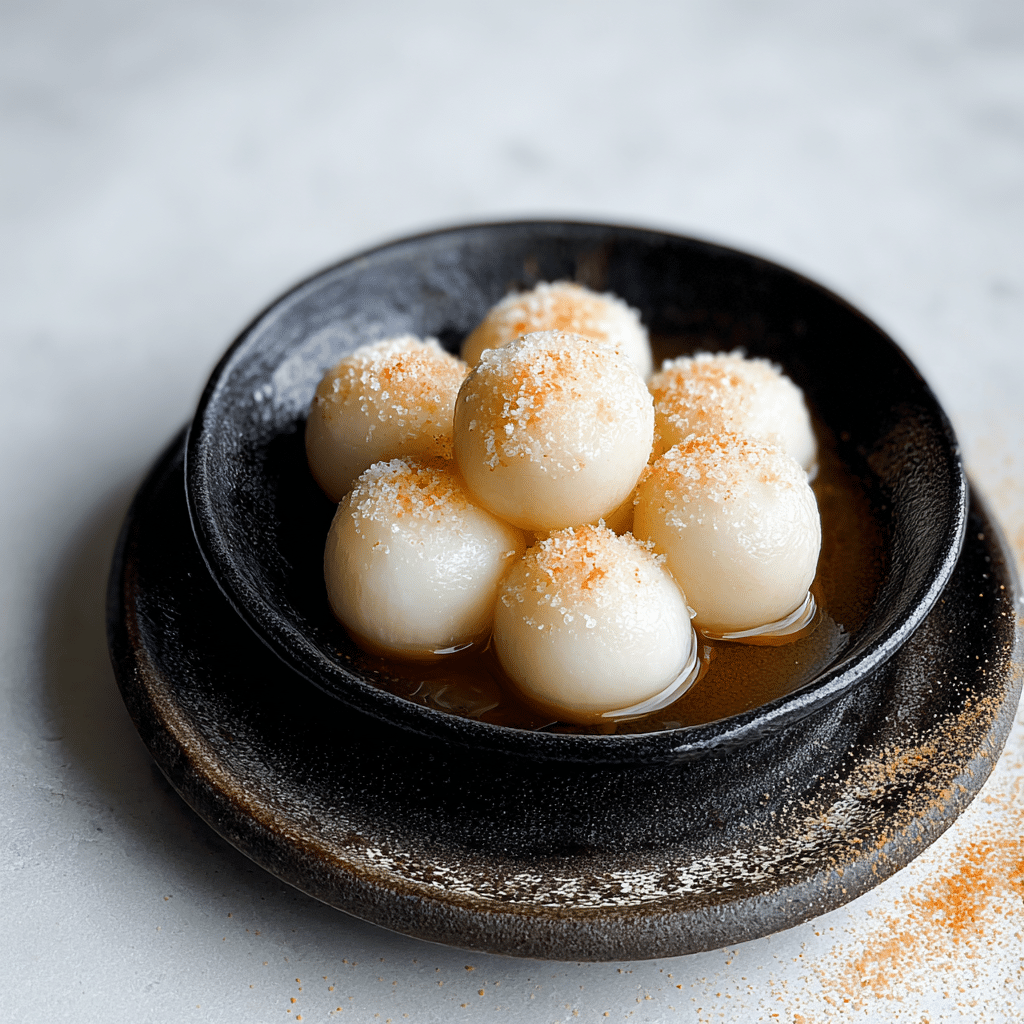
Garnishes
The most popular way to enjoy Shiratama Dango (Rice Dumplings/Mochi Balls) is with a generous drizzle of dark brown sugar syrup (kuromitsu), or a dusting of nutty roasted soybean powder (kinako). Both invite that perfect balance of sweetness and earthiness. If you’re feeling extra fancy, a touch of honey or a scoop of matcha ice cream also make wonderful companions—be as creative as you wish!
Side Dishes
Shiratama Dango pair beautifully with traditional Japanese desserts like sweet red bean paste (anko), seasonal fresh fruit, or even a refreshing cup of green tea to cleanse the palate. Turn your dango into an elegant dessert platter by adding slices of juicy peach, strawberries, or a bowl of shaved ice for those sunny days.
Creative Ways to Present
Try threading several dango onto skewers for a fun, festive vibe, or stack them atop a sundae for a modern twist. Arrange them in a pattern, or color the dough with a pinch of matcha or food coloring for a rainbow effect. You can even stuff the dango with anko paste for a surprise inside—there are endless playful ideas for showing off Shiratama Dango (Rice Dumplings/Mochi Balls) at your next gathering!
Make Ahead and Storage
Storing Leftovers
If you plan to enjoy your dango within a day or two, place them in an airtight container in the refrigerator. They may harden a bit when chilled, but don’t worry—they’ll bounce right back after a quick soak in warm water or a few seconds in the microwave.
Freezing
To have Shiratama Dango (Rice Dumplings/Mochi Balls) on hand anytime, arrange any extras in a single layer on a tray and freeze for about an hour before transferring them to a freezer bag. They’ll keep their ideal texture and flavor for up to a month, ready to be thawed out whenever you fancy a quick, chewy treat.
Reheating
You can reheat Shiratama Dango from frozen by microwaving them for about 40 to 50 seconds—or by placing the frozen balls in gently simmering water for a minute or two, just until soft and springy. Serve immediately with your favorite toppings for dango that tastes freshly made!
FAQs
Can I make Shiratama Dango (Rice Dumplings/Mochi Balls) in advance?
Absolutely! Shape and boil them ahead of time, then store in the fridge for a day or freeze for up to a month. Just reheat gently before serving to restore that wonderful chewiness.
Is there a gluten-free option for this recipe?
Yes! All the main ingredients for Shiratama Dango (Rice Dumplings/Mochi Balls) are naturally gluten-free, including shiratamako, mochiko, and potato starch. Just double-check any toppings or syrups you use to ensure they’re gluten-free as well.
Why did my dango turn out too hard or too soft?
The texture depends on the dough’s water content—too little water, and the balls will be tough; too much, and they’ll lose their shape. Aim for that “earlobe” dough texture, and be patient when adding water so you can adjust as you go.
Can I add color or flavor to the dough?
Definitely! Mix a teaspoon of matcha powder for a delicate green tea flavor, or experiment with natural food colorings to make your dango eye-catching. For special occasions, divide the dough and make pastel shades for a festival look.
What are the best toppings for Shiratama Dango (Rice Dumplings/Mochi Balls)?
Classic options include kuromitsu and kinako, but don’t be afraid to get creative—sweet red bean paste, chocolate sauce, fruit compotes, sesame paste, or even ice cream turn this basic treat into an extraordinary dessert.
Final Thoughts
Shiratama Dango (Rice Dumplings/Mochi Balls) deliver pure joy in every chewy, pillowy bite—and you don’t need to be a seasoned cook to pull them off. They’re quick, vegan, and customizable, making them a fun project for a solo treat or a family gathering. Give this recipe a try, and you’ll see why these adorable mochi balls have been loved for generations in Japan. Happy dango making!
Print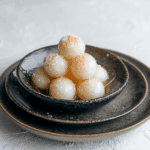
Shiratama Dango (Rice Dumplings/Mochi Balls) Recipe
- Total Time: 15 minutes
- Yield: 4-6 servings
- Diet: Vegan
Description
Shiratama Dango, also known as Japanese rice dumplings or mochi balls, are a chewy, delightful treat enjoyed in many traditional Japanese desserts. These small, soft, and smooth mochi balls are easy to make at home in under 15 minutes. Served with a variety of toppings like dark brown sugar syrup (kuromitsu), roasted soybean powder (kinako), or paired with ice cream, they offer a perfect balance of sweetness and chewy texture. Whether you’re new to Japanese sweets or a longtime fan, this recipe is a fun and delicious way to enjoy a beloved Japanese treat!
Ingredients
For the Rice Dumplings:
- Shiratamako (preferred method): 100g glutinous rice flour
- Water: 90ml (approximately)
OR
- Mochiko (alternative method): 90g glutinous rice flour, 10g potato starch (katakuriko or tapioca starch), 80ml water (approximately)
Optional Toppings:
- Dark brown sugar syrup (kuromitsu)
- Roasted soybean powder (kinako)
Instructions
- Step 1: Prepare the Dough In a bowl, whisk 100g of shiratamako (glutinous rice flour) to ensure a smooth texture. Add 90ml of water, pouring in half at a time while gently stirring to combine. (Alternative method: Mix 90g of mochiko with 10g of potato starch. Then, gradually add 80ml of water, stirring after each addition.) Gradually add the rest of the water, mixing carefully until a smooth dough forms. The dough should have the texture of an earlobe—elastic and smooth. Be cautious not to add too much water at once.
- Step 2: Shape the Dango Bring a pot of water to a boil for cooking the dango while you shape the dough. Divide the dough into equal sections. Roll each section into cylinders and cut them into approximately 10 equal pieces. Roll each piece into small balls, pressing gently in the center to create a slight indentation. Place the shaped dango on parchment paper to prevent sticking.
- Step 3: Cook the Shiratama Dango Once the water is boiling, gently drop the rice dumplings (dango) into the pot. Stir occasionally with chopsticks to prevent sticking. When the dango float to the surface (about 3 minutes), set a timer for 1 more minute. Prepare a bowl of ice-cold water for cooling.
- Step 4: Cool and Serve Turn off the heat and use a mesh spoon to transfer the dango into the ice-cold water. Let them cool for 5-10 minutes. After they cool, drain the water and serve with optional toppings such as kuromitsu (dark brown sugar syrup) or kinako (roasted soybean powder).
- Step 5: Storage and Leftovers If you have leftovers, freeze the dango by placing them on a tray lined with parchment paper for 1 hour. Then transfer to a sealable freezer bag. Frozen dango can be stored for up to 1 month. To serve, thaw them in the microwave for 40-50 seconds or soak them in warm water.
Notes
- Toppings: Shiratama dango is traditionally served with kuromitsu (dark brown sugar syrup) or kinako (roasted soybean powder). For a more refreshing twist, drizzle with honey or add fresh fruit.
- Flavor Variations: You can infuse the dough with matcha powder for a green tea flavor, or try sweetened red bean paste (anko) as a surprise filling inside the dango.
- Mochiko vs Shiratamako: Shiratamako gives the best chewy texture, but mochiko is a suitable alternative with a slightly different texture.
- Prep Time: 10 minutes
- Cook Time: 3 minutes
- Category: Dessert
- Method: Boiling
- Cuisine: Japanese
Nutrition
- Serving Size: 1 dango ball
- Calories: 80 kcal
- Sugar: 3g
- Sodium: 5mg
- Fat: 0.5g
- Saturated Fat: 0g
- Unsaturated Fat: 0.5g
- Trans Fat: 0g
- Carbohydrates: 18g
- Fiber: 0.5g
- Protein: 1g
- Cholesterol: 0mg

